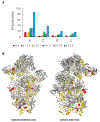Using DMS-MaPseq to uncover the roles of DEAD-box proteins in ribosome assembly
- PMID: 35550176
- PMCID: PMC10152975
- DOI: 10.1016/j.ymeth.2022.05.001
Using DMS-MaPseq to uncover the roles of DEAD-box proteins in ribosome assembly
Abstract
DMS (dimethylsulfate) is a time-tested chemical probe for nucleic acid secondary structure that has recently re-emerged as a powerful tool to study RNA structure and structural changes, by coupling it to high throughput sequencing techniques. This variant, termed DMS-MaPseq, allows for mapping of all RNAs in a cell at the same time. However, if an RNA adopts different structures, for example during the assembly of an RNA-protein complex, or as part of its functional cycle, then DMS-MaPseq cannot differentiate between these structures, and an ensemble average will be produced. This is especially challenging for long-lived RNAs, such as ribosomes, whose steady-state abundance far exceeds that of any assembly intermediates, rendering those inaccessible to DMS-MaPseq on total RNAs. These challenges can be overcome by purification of assembly intermediates stalled at specific assembly steps (or steps in the functional cycle), via a combination of affinity tags and mutants stalled at defined steps, and subsequent DMS probing of these intermediates. Interpretation of the differences in DMS accessibility is facilitated by additional structural information, e.g. from cryo-EM experiments, available for many functional RNAs. While this approach is generally useful for studying RNA folding or conformational changes within RNA-protein complexes, it can be particularly valuable for studying the role(s) of DEAD-box proteins, as these tend to lead to larger conformational rearrangements, often resulting from the release of an RNA-binding protein from a bound RNA. Here we provide an adaptation of the DMS-MaPseq protocol to study RNA conformational transitions during ribosome assembly, which addresses the challenges arising from the presence of many assembly intermediates, all at concentrations far below that of mature ribosomes. While this protocol was developed for the yeast S. cerevisiae, we anticipate that it should be readily transferable to other model organisms for which affinity purification has been established.
Keywords: Affinity purification; DEAD-box proteins; DMS; MapSeq; Ribosome assembly.
Copyright © 2022 The Authors. Published by Elsevier Inc. All rights reserved.
Figures



Similar articles
-
DMS-MaPseq for genome-wide or targeted RNA structure probing in vivo.Nat Methods. 2017 Jan;14(1):75-82. doi: 10.1038/nmeth.4057. Epub 2016 Nov 7. Nat Methods. 2017. PMID: 27819661 Free PMC article.
-
Viral RNA structure analysis using DMS-MaPseq.Methods. 2020 Nov 1;183:68-75. doi: 10.1016/j.ymeth.2020.04.001. Epub 2020 Apr 3. Methods. 2020. PMID: 32251733 Free PMC article. Review.
-
Probing in vivo RNA Structure With Optimized DMS-MaPseq in Rice.Front Plant Sci. 2022 Mar 31;13:869267. doi: 10.3389/fpls.2022.869267. eCollection 2022. Front Plant Sci. 2022. PMID: 35432393 Free PMC article.
-
Genome-wide probing RNA structure with the modified DMS-MaPseq in Arabidopsis.Methods. 2019 Feb 15;155:30-40. doi: 10.1016/j.ymeth.2018.11.018. Epub 2018 Nov 29. Methods. 2019. PMID: 30503825
-
Roles of DEAD-box proteins in RNA and RNP Folding.RNA Biol. 2010 Nov-Dec;7(6):667-76. doi: 10.4161/rna.7.6.13571. Epub 2010 Nov 1. RNA Biol. 2010. PMID: 21045543 Free PMC article. Review.
Cited by
-
Attacking a DEAD problem: The role of DEAD-box ATPases in ribosome assembly and beyond.Methods Enzymol. 2022;673:19-38. doi: 10.1016/bs.mie.2022.03.033. Epub 2022 Apr 9. Methods Enzymol. 2022. PMID: 35965007 Free PMC article.
-
A disease associated mutant reveals how Ltv1 orchestrates RP assembly and rRNA folding of the small ribosomal subunit head.PLoS Genet. 2023 Nov 1;19(11):e1010862. doi: 10.1371/journal.pgen.1010862. eCollection 2023 Nov. PLoS Genet. 2023. PMID: 37910572 Free PMC article.
-
A disease associated mutant reveals how Ltv1 orchestrates RP assembly and rRNA folding of the small ribosomal subunit head.bioRxiv [Preprint]. 2023 Jul 10:2023.07.10.548325. doi: 10.1101/2023.07.10.548325. bioRxiv. 2023. Update in: PLoS Genet. 2023 Nov 1;19(11):e1010862. doi: 10.1371/journal.pgen.1010862. PMID: 37503067 Free PMC article. Updated. Preprint.
-
The kinase Rio1 and a ribosome collision-dependent decay pathway survey the integrity of 18S rRNA cleavage.PLoS Biol. 2024 Apr 25;22(4):e3001767. doi: 10.1371/journal.pbio.3001767. eCollection 2024 Apr. PLoS Biol. 2024. PMID: 39038273 Free PMC article.
References
-
- Moazed D, Stern S, Noller HF, Rapid chemical probing of conformation in 16 S ribosomal RNA and 30 S ribosomal subunits using primer extension, J. Mol. Biol 187(3) (1986) 399–416. - PubMed
-
- Stern S, Moazed D, Noller HF, Structural analysis of RNA using chemical and enzymatic probing monitored by primer extension, Methods Enzymol. 164 (1988) 481–489. - PubMed
-
- Moazed D, Noller HF, Intermediate states in the movement of transfer RNA in the ribosome, Nature 342(6246) (1989) 142–8. - PubMed
-
- Mohr S, Ghanem E, Smith W, Sheeter D, Qin Y, King O, Polioudakis D, Iyer VR, Hunicke-Smith S, Swamy S, Kuersten S, Lambowitz AM, Thermostable group II intron reverse transcriptase fusion proteins and their use in cDNA synthesis and next-generation RNA sequencing, Rna 19(7) (2013) 958–70. - PMC - PubMed
Publication types
MeSH terms
Substances
Grants and funding
LinkOut - more resources
Full Text Sources
Molecular Biology Databases

